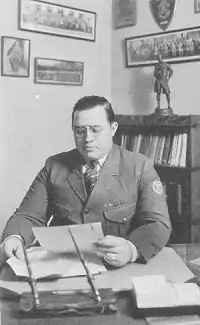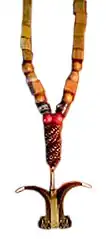| Tribe of Mic-O-Say | |||
|---|---|---|---|
| Location | Osceola, Missouri | ||
| Country | United States | ||
| Founded | 1925 (sometimes cited as founded in 1924 in Wyoming) | ||
| Founder | Harold Roe Bartle | ||
|
| |||
| Website | |||
The Tribe of Mic-O-Say is an honor society used by two local councils of the Boy Scouts of America, the Heart of America Council at the H. Roe Bartle Scout Reservation. Similar programs exist or have existed in multiple other councils as well. The Tribe of Mic-O-Say is not a program of the National Council of the BSA. Mic-O-Say's ceremonies, customs, and traditions are loosely based on the folklore of various tribes of Native Americans. Both councils use both the Tribe of Mic-O-Say and the Order of the Arrow. While there is some activity in Camp Geiger, it is technically not Mic-O-Say as all Mic-O-Say ceremonies are held at H. Roe Bartle Scout Reservation.
The Kansas City Chiefs NFL team was named by Bartle, while he was mayor there, from his nickname as founder of Mic-O-Say. BSA, Mic-O-Say, and the Chiefs have been widely criticized for cultural appropriation of native tribes.
History


Mic-O-Say was founded in 1925 at Camp Brinton near Agency, Missouri under the guidance of Harold Roe Bartle, who was the Scout executive of the St. Joseph Council, now Pony Express Council. Bartle combined his experiences in Wyoming with the St. Joseph Council's existing honor organization called Manhawka.[1]
Bartle was inspired to create the organization after serving as the Scout Executive for the Cheyenne Council of the Boy Scouts of America in Casper, Wyoming, from 1923 to 1925.[2][3] Bartle became interested in the heritage and culture of the many Indian reservations in Wyoming. He spent many hours listening to stories about the Indian tribes and soon began to incorporate Indian values and ideals into his Scouting program. Bartle claimed he was inducted into a local tribe of Arapaho based on a reservation served by the Scout council, and according to traditional Mic-O-Say legend, was given the name Lone Bear by the Chief.[4][5]
Bartle started as Scout Executive in St. Joseph, January 1925. The idea of Mic-O-Say was well formed from the moment he arrived. There already existed a camp society there called Manhawka, established by a previous executive. Bartle familiarized himself with the rudiments of it, and incorporated them into his central theme of an Indian-like society based on the principles of the Scout Oath. Bartle named the society "Micosay". A hyphenated version was used shortly after and remains popular, though the non-hyphenated version can still be used.
Camp Geiger, which succeeded Camp Brinton in 1935, is considered the mother Tribe of Mic-O-Say. Bartle was "The Chief", and conducted all the early ceremonies personally, placing a single eagle claw around the neck of each new member and bestowing their Tribal Name upon them. He built up the tribe during the next few years.
In late 1928, Bartle became the Scout executive of the Kansas City Area Council. Mic-O-Say had increased both Scouting and summer camp attendance, and he established another Mic-O-Say program at Camp Dan Sayre near Noel, Missouri, in 1929, the first summer there. Another honor program known as the 4Ms existed there at the time. In 1930 Camp Osceola opened near Osceola, Missouri, and was renamed the H. Roe Bartle Scout Reservation.
The tribe flourished and expanded rapidly at both Camps. The mother tribe in St. Joseph remained and grew. In 2014 the 20,000th tribesman was inducted into the Camp Geiger tribe.
The 75th anniversary celebration of the program at the H. Roe Bartle Scout Reservation included thousands of members of the Tribe, including previous Chief Scout Executives.
Organization

In the Heart of America Council, the Council of Chieftains, She-She-Be Council, and Tribal Council lead the tribe. Their official publications are the Customs and Traditions booklet, Cedar Smoke newsletter, and Inner Circle magazines.
In the Pony Express Council, the Council of Chieftains and the Tribal Council lead the tribe. Their official publications are the Redbook and most recently Make Talk Now which is an electronic video version of the former Make Talk magazine.
Notable members
- Harold Roe Bartle, former Mayor of Kansas City
- Sam Graves, U.S. Congressman from Missouri's 6th Congressional District, having achieved the rank of Runner as a youth and elevated in 2009 to Sachem at Camp Geiger.
- Todd Graves, former US Attorney, was elevated in June 2016 to Chieftain at Camp Geiger having served in all ranks and paint stations.
- Arliss Howard, actor playing Private Cowboy in Full Metal Jacket, wearing his Brave Pouch in various scenes
- Robert Mazzuca, Chief Scout Executive of BSA from 2007 to 2012[6]
- Ike Skelton, former U.S. Congressman from Missouri's 4th congressional district, 34 year member of the United States House of Representatives, and former Chair of the House Armed Services Committee
- Michael B. Surbaugh was an Honorary Chief from 2016
- Roy Williams, Chief Scout Executive of BSA from 2000 to 2007
Controversy
The Boy Scouts of America, and particularly Mic-O-Say, have been widely criticized by officials of several Native tribes, anthropologists, journalists, and professors for being a patently offensive cultural appropriation of tribal identity and sacred practices. It was called "a fake Indian Boy Scout tribe"[7] for people who want to "play Indian".[8][9] Robert Prue, a former scout and a professor of social work at the University of Missouri-Kansas City, doubts some of Harold Roe Bartle's historical origin claims, and rejects his claim of having become a tribal member in Wyoming, as being merely the affinity of one tribal member instead of the requisite authority of each entire tribe being depicted. Critics say that the appropriation continues because the BSA has not yet received widespread public revulsion like professional sports teams have. That includes the Kansas City Chiefs, named after Bartle's nickname from the founding of Mic-O-Say, and which has its own cultural appropriation and racism controversy.[9][10][11][12][8]
In 2015, representatives of several native tribes from the American Indian Health Research and Education Alliance met with Mic-O-Say leadership and published a five-page article in Practicing Anthropology called "For $1,000 You Can Be a Dog Soldier: The Tribe of Should-be-Ashamed". It summarized: "The Mic-O-Say have a long history of misappropriating and misrepresenting Indian culture and traditions as well as engaging in cultural imperialism. This alienates Native people from their traditions, undermines self-determination, and creates further animosity and distrust between Natives and non-Natives."[8]
Ceremonies
Mic-O-Say has several "induction" ceremonies that are so-called "public", even though many who are not within this organization do not know about them. The first notable one is the ceremony of its entry rank, referred to as Foxmen. It starts off on the fourth day of camp during the campfire night, when Boy Scouts, chosen by their troops, are inducted into the organization. They are taken to the side and are sworn into a "vow of silence." This "silence" is to "teach" these chosen Scouts to "think before they speak." They are then set aside to do some "Community" work around the camp. They are then brought back to the campfire ring and stay overnight underneath the skies. Their final ceremony takes place in the biggest campfire ring in the camp. First, these members are instructed to lay on their backs and are told about the "history" of the tribe. First is the "tribes" grueling exodus from the west coast of the US. How their ""ancestors"" went through brush and branches to escape their former homes. To demonstrate this, other members of the tribe would run around with twig branches and run them along the inductees' backs. Then the inductees are taken outside the ring and made to drink a drink nicknamed "The Bitter Drink" and to eat a bread nicknamed “The Bitter Bread.” They are brought in and explained how these "ancestors" were forced to survive off of contaminated water and food over the Rookie Mountains. The ceremony ends and the inductees are fully members of the tribe.
Scouts BSA's official policy towards "Secrets in Scouting" is:
"All aspects of the Scouting program are open to observation by parents and leaders. The BSA does not recognize any secret organizations as part of its program. Hazing and initiations are prohibited and have no part during any Scouting activity."
See also
References
- ↑ "Mic-O-Say". Troop 61. Retrieved July 2, 2019.
- ↑ "State Historical Society of Missouri Research Center - Kansas City" (PDF). Retrieved September 9, 2021.
- ↑ "History of The Tribe of Mic-O-Say". Boy Scouts of America Heart of America Council. Retrieved July 2, 2019.
- ↑ Davis, Winston (March 7, 2013). Men of Schiff, A History of the Professional Scouters Who Built the Boy Scouts of America. Lulu.com. p. 62. ISBN 978-0578112831.
- ↑ ""Lone Bear" H. Roe Bartle". US Scouting Service Project. Retrieved July 4, 2019.
- ↑ "Robert Mazzuca (Chieftain Eagle From The West)".
- ↑ "Native American journalist takes issue with Kansas City Chiefs on Twitter". KTSM 9 News. Retrieved August 11, 2022.
- 1 2 3 Sean M. Daley, Jason Hale, Shelly Eagleman Bointy, T. Edward Smith, Charley Lewis, Julia Soap, Chandler Williams, Christina M. Pacheco, and Christine M. Daley (Spring 2015). "For $1,000 You Can Be a Dog Soldier: The Tribe of Should-be-Ashamed". Practicing Anthropology. Society for Applied Anthropology. 37 (2): 17–21. doi:10.17730/praa.37.2.9x51g19018v8r461. JSTOR 24782525. Retrieved August 11, 2022.
{{cite journal}}: CS1 maint: multiple names: authors list (link) - 1 2 Klick, Andrea (August 11, 2020). "'They Know It's Wrong.' Some Call on Scouts to Change Use of Native American Culture". Kansas City Star. Retrieved August 11, 2022.
- ↑ Schilling, Vincent (September 17, 2019). "The Tribe of Mic-O-Say dance teams regularly perform' in 'Native-style regalia'". Indian Country Today. Retrieved August 11, 2022.
- ↑ Schilling, Vincent (September 21, 2019). "How the Kansas City Chiefs got their name and the Boy Scout Tribe of Mic-O-Say". Indian Country Today. Retrieved August 11, 2022.
- ↑ Cash, Meredith (January 23, 2020). "The Chiefs got their controversial name from a Kansas City mayor who went by 'Chief' and insisted on the team being named after himself". Business Insider. Retrieved August 11, 2022.
Further reading
- Cotton Smith (June 2004). Tribesmen Arise!. ISBN 0-9754963-0-1.
- Strengthened by an Eagle's Claw. ISBN 0-9754963-2-8.
- Make Talk Magazine Pony Express Council 100th Anniversary.

